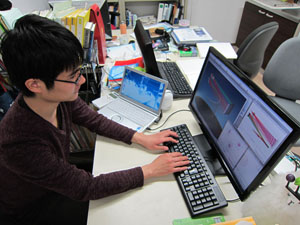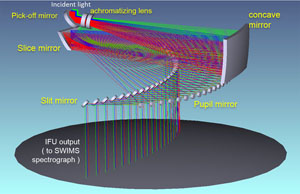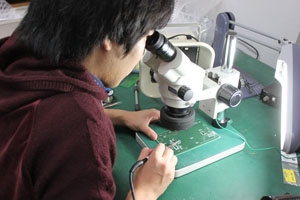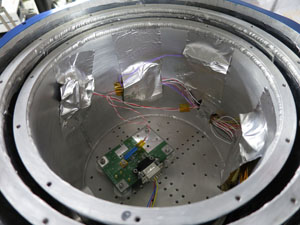
|
Two graduate students got master's degrees related to the development of the instruments of the TAO telescope!
Kitagawa and Okada, who belong to the Department of Astronomy, Graduate School of Science, the University of Tokyo, submitted master's theses related to the development of the instruments "Near-infrared multi-object spectroscopic camera SWIMS" and " The mid-infrared camera MIMIZUKU" for the TAO 6.5 m telescope, and received master's degrees in March 2014. Both instruments are developed at a rapid pace, aiming for test observations on the Subaru telescope in 2015 and the first light on TAO 6.5 m telescope in FY 2017. We will introduce the development activities of the instruments with the participation of the graduate students.
1. Development of image slicer type near infrared integral field spectroscopy unit
Department of Astronomy, School of Science, University of Tokyo
KITAGAWA, Yutaro
|
Currently, I am developing a device called an "Integral Field Unit" for integral field spectroscopy, and published its optical design as a master thesis. Integral field spectroscopy is a rapidly developing observation method with the advent of a large telescope like Subaru. In this observation method, spectra of "surface (2 dimensions)" of a target object is caught as its name shows, instead of long-slit spectroscopy which cuts out a "line (one dimension)" of the object and obtain its spectrum. Thus, in a case of a galaxy for example, it is possible to acquire spectral (wavelength) data of the entire extended region at once, and make it possible to investigate important information such as star formation rates and gas motion. Especially, integral field spectroscopic observations in the near infrared wavelength are the key to unravel how the galaxy evolved in the universe 7.5 to 10 billion years ago.
An optical system called an integral field unit (IFU) is used to realize such observations. In this research, we are developing an IFU for an instrument called SWIMS, the first generation instrument of the TAO 6.5 m telescope, which can be also installed on the Subaru telescope for observation. Originally SWIMS is an imager and multi-object spectrograph in the near infrared wavelength, and I intend to unravel the mystery of the galaxy formation and evolution mentioned above by adding an integral field spectroscopic observation mode to it.
I started with optimal optical design of an image slicer type IFU, which is widely used in the near infrared wavelength, for Subaru telescope. Specifically, I analyzed to find an optical layout that meets the required performance from the paraxial calculations and ray tracing simulations, satisfying the limitation that whole optics must be housed in a very compact size. The difficult point was that it was not obvious whether such a "desirable" solution exists, so while doing various trials and errors, I sometimes had to restart everything all over again. However, finally I found the optical solution I was looking for and was relieved with joy when I confirmed that such an optical layout can be used for observations at the summit of Mauna Kea, Hawaii. The next step is, based on the optical design obtained in this research, production of mirrors of complicated shapes with high accuracy. We also expect to be able to break through this technical issues by applying a metal cutting technology called a super precision machining.
I am looking forward to the day of conducting observations by the device I designed, firstly using the Subaru telescope, and in the future, using the TAO 6.5 m telescope. This research was conducted in collaboration with Dr. Shinobu Ozaki (National Astronomical Observatory of Japan, TMT Project Office) and SWIMS team.

A ray tracing simulation using an optical design software

The optical layout of the IFU obtained in this research
|
2. Development of low-temperature electronics for a mid-infrared instrument for a ground-based large telescope
Department of Astronomy, School of Science, University of Tokyo
OKADA, Kazushi
|
MINIZUKU, a mid-infrared instrument for the TAO 6.5 m telescope that I engaged in development, observes infrared rays with wavelength of 2~40 µmgenerally called thermal infrared. This infrared ray is suitable for observations of dust particles (fine solid particles) which are widely distributed in the universe. In the interstellar space, a molecular cloud core with high gas / dust density shrinks by self-gravity to generate a protostar, and it is thought that the dust grows in the disk accreting around the protostar to form a planetary system. On the other hand, a dying star releases gas and dust into the interstellar space and supply materials for a formation of next-generation stars. In this way, materials are circulating in the universe, and one of the big themes of MIMIZUKU is to explore the material circle of the universe through dust observations.
In my master's thesis, I summarized the development of cryogenic electronics for MIMIZUKU which is essential for mid-infrared instruments. In the mid-infrared, unlike the visible and near infrared, Earth atmosphere and a telescope glow brightly with thermal radiation, so a detector is saturated in very short timescale and it is necessary to read it out at a high speed. On the other hand, dark current (thermal noise) is easily generated in the mid-infrared detector, so it must be cooled to 10 K or less in order to suppress the dark current. Since MIMIZUKU is a large instrument and wiring for the detector signal is long, a relay buffer circuit that receives the signal of the detector and sends it out again is necessary for the high-speed readout.Considering the spatial arrangement in MIMIZUKU, it is appropriate to place the buffer circuit in a low-temperature environment of 20 K. However, at this temperature the circuit that operates at room temperature will not work properly. The biggest reason is that a silicon semiconductor element called FET (field effect transistor) used for a source follower circuit in such a buffer does not work at low temperature due to frozen carriers. Therefore, in this study, we attempted to adopt gallium arsenide FET which is generally used for high frequency applications (several 100MHz~GHzor more) to create an equivalent circuit. As expected, these FETs showed instability which is thought to be due to high frequencies, and we had difficulty in handling, but finally succeeded in selecting a suitable element for use for the buffer circuit of MIMIZUKU.
The next step is to design a multichannel circuit that can actually be mounted on MIMIZUKU and conduct its performance test. MIMIZUKU as a whole aims at completion in 2014, and we are working hardly for that.

Making a circuit board for a demonstration test of a cryogenic source follower

Setup for the demonstration test of the cryogenic source follower
|
|





